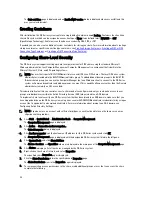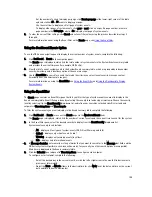
•
Current Bytes (current number of ingested bytes in container)
•
Cleaner Status (current space reclamation process status for the selected container)
For more information on DR Series system CLI commands, see the
Dell DR Series System Command Line Reference
Guide
.
Managing Replication Operations
If you plan on performing replication operations across a firewall, the DR Series system replication service requires that
the following fixed TCP ports be configured to support replication operations:
NOTE: To allow replication storage information to be viewed by a corresponding data management agent (DMA),
the target DR Series system needs to reside in the same domain as the source DR Series system in the replication
relationship.
•
port 9904
•
port 9911
•
port 9915
•
port 9916
NOTE: If there are no existing containers, replication relationships, or any scheduled replication operations, the
only Replication-related option that is enabled is Create. The Edit, Delete, Stop, Start, Bandwidth, and Display
Statistics options are disabled (grayed out).
In the 2.0 release, DR Series systems support 32:1 replication of data. This means that multiple source DR Series systems
(up to 32) can write data to different individual containers on a single, target DR Series system.
NOTE: Starting with Release 2.0, the DR Series system software includes version checking that limits replication
only between other DR Series systems that run the same system software release version (DR Series systems
running Release 2.0.x software can only replicate with other DR Series systems that run the same release system
software). For example, Release 2.0.x systems will not be able to replicate with Release 2.1 or Release 3.0 systems,
but can replicate with systems running Release 2.0.0.1 or 2.0.0.2.
NOTE: You need to be aware that the storage capacity of the target DR Series system is directly affected by the
number of source systems writing to its containers, and also by the amount being written by each of these source
systems.
Creating Replication Relationships
To create a new replication relationship, complete the following:
1.
Select Storage
→
Replication.
The Replication page is displayed, which lists all current replication entries by the following categories:
– Local Container Name
– Role (target or source)
– Remote Container Name
– Peer State (online or offline)
– Bandwidth (replication bandwidth limit)
NOTE: Bandwidth is the replication bandwidth limit that you can set as Kibibytes per second (KiBps),
Mebibytes per second (MiBps), Gibibytes per second (GiBps), or as an unlimited bandwidth (default).
2.
Click Create in the options bar.
94
Содержание PowerVault DX6112
Страница 1: ...Dell DR Series System Administrator Guide ...
Страница 32: ...32 ...
Страница 70: ...70 ...
Страница 86: ...86 ...
Страница 100: ...For more information on Replication schedules see Creating a Replication Schedule 100 ...
Страница 114: ...114 ...






























